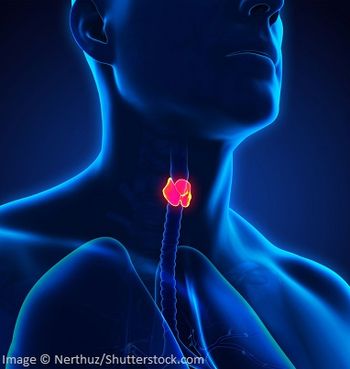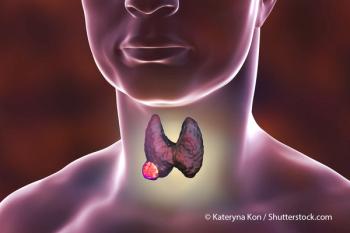
Oncology NEWS International
- Oncology NEWS International Vol 6 No 3
- Volume 6
- Issue 3
Neck Check Exam Aims at Early Detection
NEW YORK--Thyroid cancer is diagnosed in an estimated 15,600 Americans every year. As with many cancers, early detection is the key to effective treatment. Yet because thyroid cancer is asymptomatic, an enlarged thyroid or nodule on the gland is often the only sign that a malignancy is present.
NEW YORK--Thyroid cancer is diagnosed in an estimated 15,600 Americansevery year. As with many cancers, early detection is the key to effectivetreatment. Yet because thyroid cancer is asymptomatic, an enlarged thyroidor nodule on the gland is often the only sign that a malignancy is present.
A simple self-examination technique will enhance early detection, accordingto the American Association of Clinical Endocrinologists (AACE). At a pressbriefing, Stanley Feld, MD, of the University of Texas Southwestern MedicalSchool, Dallas, introduced the new "neck check" examination andthe slogan, "Stick Your Neck Out, America."
Calling it the "forgotten cancer," Dr. Feld, who is co-chairof the
"Between 50% and 60% of the American population has thyroid nodules,of which as many as 10% are cancerous," Dr. Feld said. "But ofan estimated 3 million thyroid cancers, fewer than 16,000 are diagnosedeach year." The opportunity for effective treatment and, in many cases,cure is thus lost to many.
With proper treatment, thyroid cancer has a high survival rate, Dr.Feld noted. "There are an estimated half million thyroid cancer patientsin the United States alive today, including many whose cancers were diagnosedand treated more than 40 years ago," he said.
The association calls on physicians to join the public education campaignby teaching the self-examination technique. Dr. Feld emphasized that abnormalitiesfound through the self-exam could be either an enlarged thyroid or a malignantgrowth. Referral should be made to a clinical endocrinologist for a fullevaluation, including a fine-needle aspiration biopsy of the thyroid todetermine whether cancer is present.
Performing the Neck Check
The thyroid self-examination, which should be performed monthly, requiresonly a hand-held mirror and a glass of water. The individual holds themirror so that the area of the neck just below the Adam's apple is visible,then tips back the head. After taking a sip of water, the person swallowswhile looking at the neck.
If the thyroid is normal, a ridged area will be visible on the neckas the larynx moves with the swallowing action.
If bulges or protrusions are seen instead, the thyroid should be checkedby a medical professional.
AACE recommends the neck check be done once a month, and hopes thatit will become as routine as breast self-examination. Thyroid cancer mostcommonly strikes between the ages of 25 and 65, but even children shouldbe taught to do the neck check, Dr. Feld said. Further, he said, it shouldbe part of the routine medical examination. Physicians are urged to lookfirst and palpate only after observing the neck while the patient swallows.
High-Risk Populations
People exposed to external radiation to the head and neck, a relativelycommon practice until the 1950s, are at greatest risk for developing thyroidcancer, he said. With its long latency period, thyroid cancer is showingup in patients who are now middle-aged.
Less commonly, some medullary thyroid carcinomas (MTC) may be familialand may be associated with one of the
Articles in this issue
almost 29 years ago
Bills Address Women's Health and Cancer Issuesalmost 29 years ago
Possible Evolutionary Advantage Seen in Breast Cancer Genesalmost 29 years ago
Physicians Urged to Listen to Tamoxifen Users' Concernsalmost 29 years ago
NCAB to Consider Mammography in Fortiesalmost 29 years ago
Endocrinologists Issue Clinical Guidelines for Thyroid Canceralmost 29 years ago
Fatigue May Be Most Under-recognized, Undertreated Cancer-related Symptomalmost 29 years ago
Hormone Replacement Therapy: Making Informed Decisionsalmost 29 years ago
AHCPR Issues Colorectal Cancer Screening Evidence ReportNewsletter
Stay up to date on recent advances in the multidisciplinary approach to cancer.

















































































